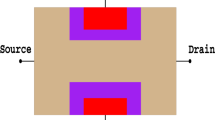Abstract
A full-band Monte Carlo simulator has been used to analyze and compare the performance of n-channel double-gate MOSFETs and FinFETs. Size quantization effects were accounted for by using a quantum correction based on Schrödinger equation. FinFETs are a variation of typical double-gate devices with the gate surrounding the channel on three sides. From our simulations, we observed that the quantization effects in double-gate devices are less significant as compared to bulk MOSFETs. The total sheet charge density drops only slightly as the depletion of charge at the interface is counterbalanced by the increased volume inversion effect. We also observed an appreciable drop in average velocity distribution when quantum corrections were applied. For FinFETs, the fin extension lengths on either side of the gate affect the device performance significantly. These underlap regions have low carrier concentration and behave as large resistors. The current drops non-linearly with increasing fin extension lengths.
Similar content being viewed by others
References
Semiconductor Industry Association. (2001). International Technology Roadmap for Semiconductors. Online at: http:// public.itrs.net/Files/2001ITRS/Home.htm.
Y. Choi, N. Lindert, P. Xuan, S. Tang, D. Ha, E. Anderson, T. King, J. Bokor, and C. Hu, IEDM Tech. Dig., 421 (2001).
G. Pei, J. Kedzierski, P. Oldiges, M. Ieong, and E.C. Kan, IEEE Trans. Electron Devices, 49, 1411 (2002).
H. Tsuchiya and T. Miyoshi, IEICE Trans. Electron, E82-C, 880 (1999).
D. K. Ferry, Superlattice Microstructures, 27, 61 (2000).
M.V. Fischettiand S.F. Laux, Physical Review B, 48, 2344 (1993).
S. Yamakawa, H. Ueno, K. Taniguchi, C. Hamaguchi, K. Miyatsuji, K. Masaki, and U. Ravaioli, J.Appl. Physics, 79, 911 (1996).
A.S. Spinelli, A. Benvenuti, and A. Pacelli, IEEE Trans. Electron Devices, 45, 1342.
S.A. Hareland, S. Krishnamurthy, S. Jallepalli, C.-F. Yeap, K. Hasnat, A.F Tasch,and C.M. Maziar, IEEE Trans. Electron Devices, 43, 90 (1996).
B. Winstead and U. Ravaioli, IEEE Trans. Electron Devices, 50, 440 (2003).
A. Duncan, U. Ravaioli, and J. Jakumeit, IEEE Trans. Electron Devices, 45, 867 (1998).
Author information
Authors and Affiliations
Rights and permissions
About this article
Cite this article
Kathawala, G.A., Mohamed, M. & Ravaioli, U. Comparison of Double-Gate MOSFETs and FinFETs with Monte Carlo Simulation. Journal of Computational Electronics 2, 85–89 (2003). https://doi.org/10.1023/B:JCEL.0000011404.60973.8a
Issue Date:
DOI: https://doi.org/10.1023/B:JCEL.0000011404.60973.8a




